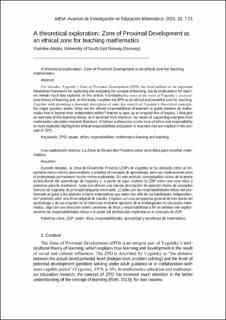| dc.contributor.author | Abtahi, Yasmine | |
| dc.date.accessioned | 2022-03-24T10:30:51Z | |
| dc.date.available | 2022-03-24T10:30:51Z | |
| dc.date.created | 2022-01-25T11:26:14Z | |
| dc.date.issued | 2021 | |
| dc.identifier.citation | Abtahi, Y. (2021). Una exploración teórica: La Zona de Desarrollo Próximo como zona ética para enseñar matemáticas. Avances De Investigación En Educación Matemática, (20), 7–21. | en_US |
| dc.identifier.issn | 2254-4313 | |
| dc.identifier.uri | https://hdl.handle.net/11250/2987288 | |
| dc.description.abstract | For decades, Vygotsky’s Zone of Proximal Development (ZPD) has been utilized as an important theoretical framework for exploring and analysing the concept of learning, but its implications for teachers remain much less explored. In this article, I conceptualise some of the roots of Vygotsky’s sociocultural theory of learning and, on this basis, I explore the ZPD as an ethical and powerful zone for teaching. Together with providing a thorough description of some key aspects of Vygotsky’s theoretical concepts, the major question stated, What are the ethical responsibilities of teachers to guide students do mathematics that is beyond their independent ability? intends to open up an original line of inquiry. I first give an overview of this learning theory, as it stemmed from Marxism, my means of supporting examples from mathematics education research literature. It follows a discussion on the issue of ethics and responsibility to more explicitly highlight the ethical responsibilities and power of teachers that are implicit in the concept of ZPD. | en_US |
| dc.language.iso | eng | en_US |
| dc.rights | Navngivelse-Ikkekommersiell 4.0 Internasjonal | * |
| dc.rights.uri | http://creativecommons.org/licenses/by-nc/4.0/deed.no | * |
| dc.title | A theoretical exploration: Zone of Proximal Development as an ethical zone for teaching mathematics | en_US |
| dc.title.alternative | Una exploración teórica: La Zona de Desarrollo Próximo como zona ética para enseñar matemáticas | en_US |
| dc.type | Peer reviewed | en_US |
| dc.type | Journal article | en_US |
| dc.description.version | publishedVersion | en_US |
| dc.rights.holder | © The Author(s) 2021. | en_US |
| dc.source.pagenumber | 7-21 | en_US |
| dc.source.journal | Avances de Investigación en Educación Matemática (AIEM) | en_US |
| dc.source.issue | 20 | en_US |
| dc.identifier.doi | https://doi.org/10.35763/aiem20.4038 | |
| dc.identifier.cristin | 1989316 | |
| cristin.ispublished | true | |
| cristin.fulltext | original | |
| cristin.qualitycode | 1 | |

